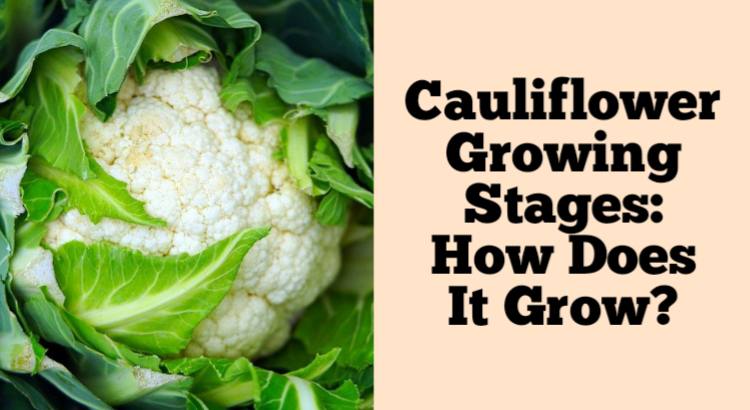Cauliflower Growing Stages. Cauliflower is a cool-season crop that requires well-drained soil, full sun, and moderate amounts of water. Cauliflower can be grown as a spring or fall vegetable and will produce heads within three months after planting seeds.
But how do you know when to harvest your cauliflower? Let’s take a closer look at each stage of growth so you can decide when it’s time to harvest your own cauliflower.
Cauliflower Growing Stages
Stage 1. Seed
Cauliflower seeds are planted in seedling trays or flats, where they grow for about two weeks until transplanting time.
Cauliflower plants are typically transplanted into a prepared field when they reach eight to ten inches tall and have developed several sets of leaves or buds.
The small green structures that grow out from the main stalk at intervals along it.
It is important to keep the plants evenly spaced, about 18 inches apart. This helps them get good air circulation and drainage
Stage 2. Seedling
The cauliflower seedlings are very small and fragile, so they should be planted in a shallow tray with a potting mix that is moist but not soggy.
They should also be kept at a temperature of 55 to 60 degrees Fahrenheit. If you have trouble growing your cauliflower seedlings, try giving them more light and warmth.
If possible, place them under grow lights or near windows where they’ll get sunlight during the day.
Stage 3. Transplanting
Cauliflower plants can be transplanted into the ground or containers at any time after they emerge from the soil, but it’s important that you plan ahead.
Transplanting is the process of moving a plant from its original growing environment to a new one.
You might do this when you need more space or if your plants are overcrowded and need more light. Be sure to choose a location with plenty of room for your cauliflower plants to grow.
If you live in an area where winters are cold, wait until after all danger of frost has passed before transplanting your cauliflower.
The soil should be warm enough for root development and growth by then, but not too hot for their delicate leaves—the ideal temperature range is about 70°F–75°F (21°C–24°C).
If you have decided not to wait until later in spring and have already started growing your crop outdoors without proper protection from frost damage in mind, here’s what you should do:
First, dig up each plant carefully by its roots without disturbing them too much; then gently replant them back into pots filled with moistened potting mix until summer arrives when they’ll be ready for transplanting again once again.
Stage 4. Vegetative Growth (Establishing)
Another phase of cauliflower is the vegetative growth stage. It’s a quick-growing phase, and it’s when your cauliflower plant is still small with a large number of leaves.
This is the most important stage in cauliflower growth because it establishes all the structural components of your plant and sets up its foundation for future growth.
Stage 5. Flowering or Head Formation
Your cauliflower is almost there. When you see the first flower forming on your plant, it’s time to let go and enjoy watching nature at work.
The head or curd will form after the flowers bloom, and it will be ready to harvest in about 60 days.
Plants need constant and consistent moisture, particularly during hot weather when blossoming and head formation are occurring.
If plants are not watered consistently, they will not bloom or form a head (the part of the plant we eat).
Stage 6. Harvesting
Harvesting is the most exciting part of the process. It’s a lot easier to harvest regularly and get consistent results than it is to wait until your cauliflower is ready, then try to make all of it fit in your refrigerator.
If you want great quality cauliflower, harvesting regularly is also important—so don’t wait until it gets too big.
The best way to harvest is by cutting off the head of leaves at soil level with a sharp knife or scissors, leaving the stem in the ground so that it can continue growing new heads.
After harvesting, the cauliflower heads should be handled carefully so as not to damage their compact head.
The best way to store them is by placing them in a cool, moist place with good air circulation.
They should not be kept in direct sunlight or heat and should be kept away from drafts and pests.
Stage 7. Bolting and Seed Formation
After the cauliflowers reach their maturity they will start bolting and will produce seeds.
The plants will produce long stalks on which flowers grow on them and pods will be formed after a few weeks.
Seeds can be collected once the pods turn brown and start to dry. Each pod will have a few cauliflower seeds.
Cauliflower harvesting is one of the most exciting moments you will experience
Harvesting is one of the most exciting moments you will experience in your life and it’s also the best time to taste your produce.
It’s often a long wait for something you want so badly and finally, when it arrives it makes everything worthwhile.
Seeing your efforts pay off is a great feeling, so don’t let this moment pass by without enjoying all its glory.
Cauliflower Growing Stages: Conclusion
Cauliflower is one of the most exciting moments you will experience as a gardener. It’s not just about the delicious taste and texture of the vegetable, but also about knowing that you have successfully grown something from seed to harvest in your own backyard.

